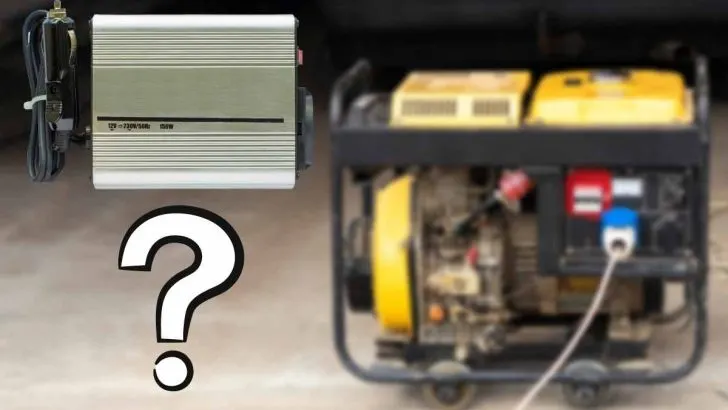Many people purchase a portable generator to keep the lights on and the refrigerator running during a power outage. Modern portable generators have been revamped to deliver smoother waves of power instead of the sometimes spotty way traditional generators produce electricity.
You do not need an inverter if you have a traditional generator, especially if the current one is working well. However, having an inverter working alongside your generator gives you a three-step process of electricity production that is cleaner, more efficient, and safer.
Generators are excellent for providing backup power in emergencies, and I will explain why adding an inverter is a plus. Keep reading to understand the circumstances that warrant having a generator, how a generator operates, and the difference adding an inverter can make.
Reasons Why You Would Need a Generator
There are multiple reasons why you would need a generator. Think of the times you have had a power blackout and panicked because there was no way to know when the electricity company would restore it. Electricity has become essential in our lives, causing several problems when it goes out.
Below are some of the reasons behind the need for a generator.
- When intense rain, snow, or ice storm bring down power lines, you can lose access to power. Since municipal power supply is on a grid system, losing power along with many other homes and businesses is inconvenient and sometimes dangerous.
- Many homes have appliances and essential aids that require electricity. Consider an older person who needs to use an electric chair lift or one who needs a CPAP to breathe at night.
- Loss of heat in some parts of the country in wintertime can be dangerous. When power goes out, using propane heaters is hazardous. So a generator is critical for providing at least some heat and lights to your home until power gets restored.
Unexpected storms like tornadoes, hurricanes, and flash floods can cause significant disruptions. These include food loss in the refrigerator and freezer, issues with appliance aids for health issues, and extreme temperatures in your home. A generator will help to remedy some of those problems by powering the most essential needs (source).
How a Traditional Generator Works To Produce Electricity
A gas-powered generator creates electricity from an internal combustion engine. As the motor spins the shaft, it rotates an electromagnet. This rotating magnet spins within a motionless magnetic field to produce energy that feeds through copper wiring.
Components of a Traditional Generator for Creating Energy
The generator creates energy using a gas-powered engine. This engine rotates the shaft in the magnetic field to produce the electricity your home needs to keep essential appliances and other select features working during a power outage.
Here are the parts the generator uses to make electricity (source).
- The engine provides mechanical energy to operate the alternator.
- The mechanical energy flows into the alternator that converts the energy into electrical energy.
- Gas most often fuels a traditional generator for approximately five to six hours.
- The voltage regulator controls the constant state of power the generator produces.
- A cooling system keeps the components of the generator from overheating.
- As with any engine, the generator produces exhaust fumes that must funnel to the outside to avoid carbon monoxide poisoning.
- All engines with moving parts need a lubrication system to protect the components from excessive wear and tear.
- Batteries start a cold engine, so the generator has a battery charger to maintain the charge when the engine is not in use.
- The generator control panel allows you to see the gauges to monitor the workings and energy output.
A traditional gas-powered generator produces alternating current (AC) power, which changes direction periodically. Most houses are wired for AC currents since this is the electrical current that runs many appliances.
How an Inverter Generator Works
An inverter generator also produces AC power that is converted into direct current (DC) power. A microprocessor then returns the DC power into AC power but in a cleaner form. The energy passing through these three steps gives a more reliable electrical current.
Reasons You Would Need an Inverter Generator
There are many reasons you would need an inverter generator over a traditional generator. Much of the reasoning has to do with increased safety, but there are other compelling rationales.
- Many inverter generators have a CO2 sensor that automatically turns off the generator when the levels are too high. A traditional generator has the likelihood of carbon monoxide poisoning from the CO2 fumes of the engine.
- The inverter generator doesn’t run at full speed all the time, instead it throttles up when more electricity is needed. A traditional generator runs at top speed continuously.
- An inverter generator is generally quiet enough for you to carry on a normal conversation nearby. One of the drawbacks of a traditional generator is that they are very loud and disruptive.
Where Can You Use an Inverter Generator?
Most inverter generators are portable enough to take on camping trips and outdoor adventures. They are ideal for food trucks and mobile coffee carts. You can use the inverter to power appliances when there is an outage due to a storm and for extra string lights for an evening cookout.
Can You Add an Inverter to a Generator?
You can add an inverter to your existing generator. The inverter handles the critical loads when the generator fails to supply consistent AC electricity. This way, the inverter boosts the generator’s performance while operating in a safer capacity.
Conclusion
While adding an inverter to a generator is not necessary for energy output, it will increase production efficiency. You will get a longer run time for the generator without having to refill the gas as often, less noise, and increased CO2 safety, all of which seem to be reasons persuasive enough to add an inverter.
Recommended Reading

